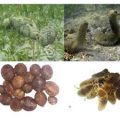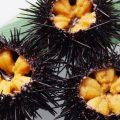This special dance happens only on a night when the setting is conducive. Like a waiting princess, she stands with head held high, her front end raised from the bottom. Meanwhile, he watches her at a distance, shaking and tossing restlessly á la lambada. A few hours later, he releases a hazy fluid that covers them both. She follows after some minutes, releasing thousands of eggs.

The sea cucumbers have spawned. The dance was successful. In 70 days, about a thousand infant sea cucumbers, all creation of the peculiar dance, will be pitching themselves on the sea floor, waiting to start another generation or to serve as haute cuisine to predators, whichever comes first.
But for Dr. Ruth Gamboa, a marine biologist from the University of the Philippines-Mindanao, understanding the dance of the sea cucumbers is very important. Dr. Gamboa leads a three-year resource management and culture program on Holothuria scabra Jaeger, or sea cucumbers, which aims to help out a bit in producing sea cucumber babies for their research.
“We mix the sperm and the egg to come up with a new generation of sea cucumbers,” she says. Experiments so far showed that H. scabara spawns three nights after the first quarter, while another variety called Bohaschia simillis spawns three nights after the full moon. “Timing is very important,” she points out.
This new generation of sea cucumbers is just what Gamboa needs in determining the best way to grow sea cucumbers in Philippine setting, particularly in Davao, and develop steps to improve the local sea cucumber production.
Backed by a P2.2 million fund from the Department of Science and Technology’s Small Enterprises Technology Upgrading Program (SETUP), Gamboa’s team now grows about 2,000 baby sea cucumbers released in two project sites in Davao del Sur and Samal Island. These were hatched in two locations, both used for free courtesy of private partners Alson’s Aquaculture Technologies facility, and High Ponds Resort.
During a recent visit by DOST Secretary Estrella F. Alabastro and Asst. Secretary Carol M. Yorobe, the research team explained the application of “low technology” for the project, which means using cost-effective operation procedures.
“We found out through experiments that the sea cucumbers could manage to thrive by feeding on just one kind of algae,” Garcia explained. Sea cucumber hatcheries commonly use or feed three kinds of algae, which makes the venture expensive.
After discovering the spawning habits of sea cucumbers, Gamboa’s next task is to determine how many days will take a sea cucumber to reach maximum commercial-grade weight of 250-300 grams under specific conditions.
Latest figures from the Food and Agriculture Organization reveal that the Philippines produced 1,079 tons of sea cucumber in 2004 valued at US$ 2,176,000, which is 21.9% of total world output.
Sea cucumber trading in the country dates back to late 18th century. It was shipped away in dried form called trepang to China, Hong Kong, Japan, Korea, Singapore, and Taiwan according to Poh-Sze Choo from the Malaysia-based Worldfish Center.
Supply of sea cucumber is declining as a result of overfishing, lack of fishing regulation, and poor understanding of its ecology, Choo says. Gamboa’s research is expected to help accelerate the development and refinement of resource management and culture methods for sea cucumbers.
Sea cucumbers are valued for their nutritional, medicinal, and commercial uses.
Last year, DOST’s Philippine Council for Aquatic and Marine Research and Development, and Philippine Council for Industry and Energy Research and Development launched sea cucumber-based snack foods, sauce, jelly, and other value-added food products.
Written by Framelia V. Anonas, dost.gov.ph





